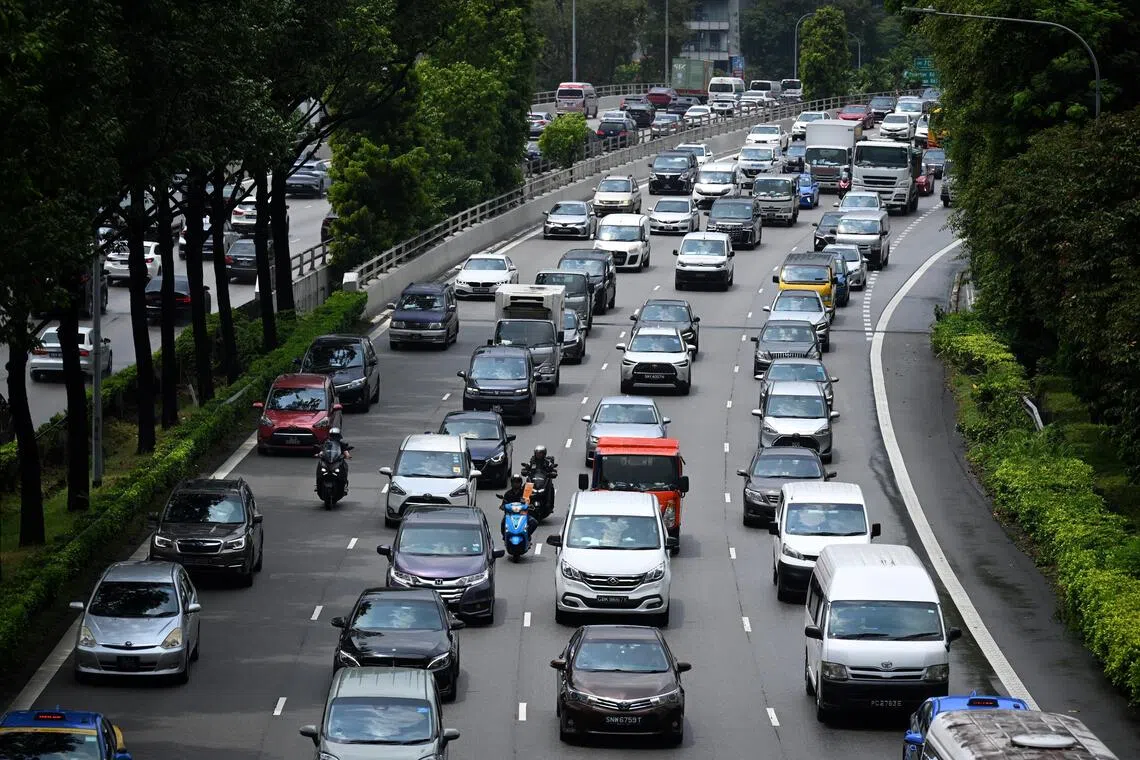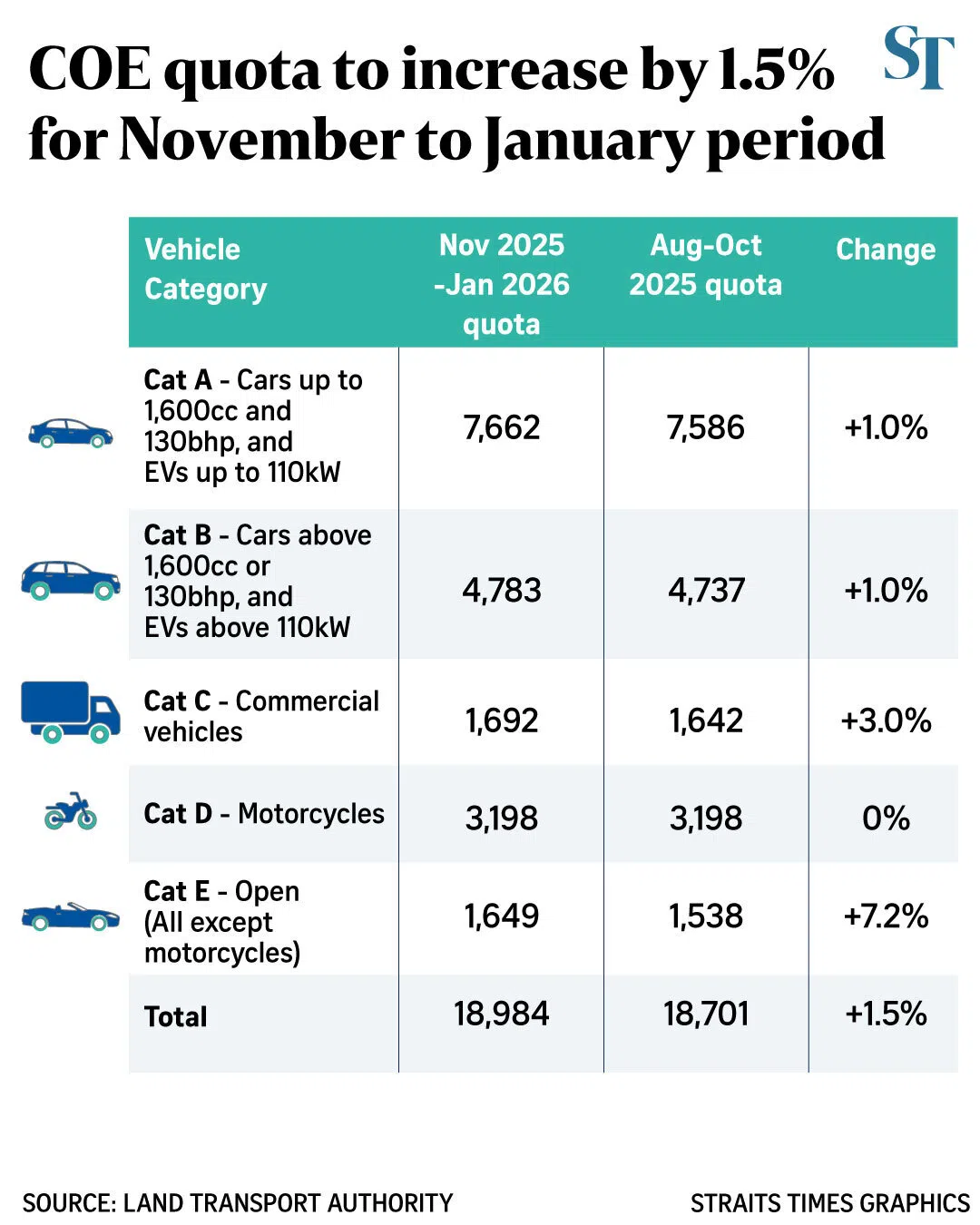COE quota to increase by 1.5% for November to January period
Sign up now: Get ST's newsletters delivered to your inbox

LTA said that the supply of Category A COEs is expected to peak and even out in this and the coming quarters.
ST PHOTO: CHONG JUN LIANG
Follow topic:
- COE supply will increase by 1.5% to 18,984 for November-January, with Category A rising 1% and Category B rising 1% (LTA announcement).
- Category E COEs will rise by 7.2%, and Category C by 3%, while Category D remains the same.
- LTA aims to stabilise COE supply amidst strong EV demand, with premiums expected to stabilise around April 2026 after incentive changes.
AI generated
SINGAPORE – The number of certificates of entitlement (COEs) available for the three months from November will rise to 18,984 – 1.5 per cent more than the 18,701 certificates available from August to October.
The Land Transport Authority (LTA) announced on Oct 24 that there will be 7,662 Category A COEs, meant for smaller and less powerful cars and electric vehicles (EVs), available for bidding between November 2025 and January 2026.
This is a 1 per cent increase over the 7,586 COEs between August and October, and translates to fewer than 13 more Category A certificates for each of the upcoming tender exercises.
“COE supply for Category A is expected to peak and even out supply in this and the coming quarters,” LTA said.
COEs give people the right to own a vehicle in Singapore. A tender exercise is conducted twice a month.
The supply of Category B COEs for larger and more powerful cars and EVs will also rise by 1 per cent in the next three months, to 4,783 from the current 4,737 available.
The Open category (Category E) COE supply will go up by 7.2 per cent, from the current 1,538 certificates to 1,649 certificates.
While Open category COEs can be used to register any vehicle type other than motorcycles, they are almost always used for bigger, more powerful cars.
Taken together, the supply of Category B and E COEs will increase by 2.5 per cent. This works out to 26 more COEs available for larger cars per tender than in the current period.
The number of commercial vehicle (Category C) COEs for bidding will increase by 3 per cent to 1,692 pieces, up from 1,642.
At 3,198, the number of COEs for motorcycles (Category D) for the new period is the same as for the August to October period.

The main determinant of the COE supply in a given three-month period is the rolling average of deregistrations in the previous four quarters.
To smoothen out the COE supply, LTA started bringing forward COEs that are due to expire in the next projected supply peak for redistribution from May 2023.
LTA also started injecting additional COEs across the vehicle categories from February 2025. Up to 20,000 more COEs will be added to the overall supply over the next few years.
The latest COE supply announcement comes a day after the latest COE tender
In recent months, Category A COE premiums hit record highs over three consecutive exercises, fuelled in part by the rush to register new cars ahead of a reduction in incentives of up to $10,000 for EVs that applies from Jan 1, 2026.
In a Facebook post following the COE supply announcement, LTA said that despite the quarterly supply of COEs in 2025 being double that of 2023, demand has been high, driven by the availability of cheaper Chinese EVs and the strong Singapore dollar.
“While the COE may not be a perfect system, it is the fairest and most effective way to allocate a scarce resource in Singapore’s context,” said LTA on the need to control the overall car population in the land-scarce island.
The supply of COEs in the two car categories for the August to October period was also 1 per cent above the preceding May to July period.
Mr Nicholas Wong, chief executive of Honda agent Kah Motor, said it seems that LTA is focused on stabilising the supply – and not the price – of COEs.
Even so, Mr Ron Lim, head of sales and marketing at Nissan agent Tan Chong Motor, said some dealers had hoped for a larger increase in the latest round to help meet the high demand spurred by LTA’s announcement about reducing EV and hybrid incentives.
With the latest COE supply announcement, Mr Lim expects COE premiums to stabilise around April or so, after the market adjusts to the reduced incentives.
The price of Category A COEs tends to be lower than that of Category B. This has led to the influx of low-powered versions of premium EVs so they can qualify for Category A COEs instead of Category B. Examples include offerings from BYD, Volvo and Tesla, said industry experts.
On LTA’s statement that the supply of Category A COEs is expected to peak soon, Mr Anthony Teo, managing director at Sime Motors, distributor of BYD, sees it as a signal that the supply for this type of COEs will likely stay at the current level in future.
Ms Corinne Chua, managing director of Volvo at Wearnes Automotive, said this would mean that the price difference between the two COE categories may become narrower.
At the most recent exercise, the Category A COE price was $122,000 – $9,889 below Category B’s $131,889, compared with $10,900 in 2024 and $44,001 in 2023.


